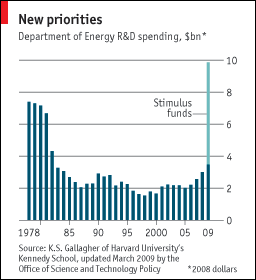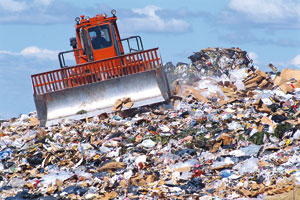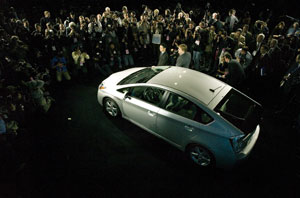American innovation faces its biggest test for decades
In the dark hours of the second world war, scientists of the Manhattan Project worked secretly in the hills of Tennessee. This month, tucked in those same hills, scientists at Oak Ridge National Laboratory sat listening to their new mission. Thomas Mason, Oak Ridge’s director, stood beside a slide show, letting its contents sink in. The budget for the Department of Energy (DoE), a chart showed, was $24.2 billion in 2008. This year Congress gave the DoE $38.7 billion in the stimulus package and another $27 billion in appropriations. Mr Mason’s main message was simple: “We’ve really got to deliver.”
 Politicians have been making noises about energy independence and climate change for some time. Federal spending on research and development, however, has remained far below the levels of the 1970s (see chart). Now rhetoric is finally being matched by cash. Within the DoE’s budget, Congress has appropriated $7.8 billion for energy R&D, 18% more than last year, and the stimulus provided about $8 billion. On March 23rd President Barack Obama and Steven Chu, the energy secretary, explained how some of the money would be spent, with money for labs—a new building at Oak Ridge will house researchers for solar batteries and superconducting transmission lines—as well as support for scientists exploring everything from carbon sequestration to hydrogen. Spending money, however, is easy. Results require hard work.
Politicians have been making noises about energy independence and climate change for some time. Federal spending on research and development, however, has remained far below the levels of the 1970s (see chart). Now rhetoric is finally being matched by cash. Within the DoE’s budget, Congress has appropriated $7.8 billion for energy R&D, 18% more than last year, and the stimulus provided about $8 billion. On March 23rd President Barack Obama and Steven Chu, the energy secretary, explained how some of the money would be spent, with money for labs—a new building at Oak Ridge will house researchers for solar batteries and superconducting transmission lines—as well as support for scientists exploring everything from carbon sequestration to hydrogen. Spending money, however, is easy. Results require hard work.
The Manhattan Project yielded the atomic bomb; the Apollo programme sent a man to the moon. Mr Obama’s goal to cut emissions by 80% by 2050 is at least as ambitious. Meeting this deadline will require not just a price on carbon and the wide adoption of existing technology, but inventions that are still just a glimmer in someone’s eye. Making matters more complex, new innovations must be deployed by companies and used by the public. The atomic bomb and the space shuttle had the government as their only customer.




Recent Comments